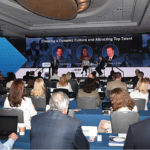
The NASA computers that put two men on the moon in 1969 had less processing power than a contemporary smartphone, Kaku said, and the trend toward smaller, cheaper, and more powerful computers has grown exponentially. By 2020, computer chips will cost a penny apiece and “the Internet will be everywhere,” he predicted.
Google’s buzzy Glass product — prototypical eyewear that displays digital images and text to augment a wearer’s experience — is just the beginning. As unlimited virtual information is embedded in everyday objects, Kaku said, contact lenses will translate other languages in conversation, displaying subtitles; workers will see through walls, by way of lenses connected to cameras in other rooms; and “robo-docs” will answer 99 percent of all common medical questions. In fact, as virtual information increasingly is “imposed on reality,” computers will disappear, Kaku said, in the same way that electricity has become an invisible part of our environment.
What the futurist doesn’t expect to disappear, however, are meetings like the 14-year-old DigitalNow, which is produced by Fusion Productions and the Disney Institute. The sold-out 2013 conference — subtitled “The Big Bang” — was held April 4–6 at Disney’s Contemporary Resort in Walt Disney World, and drew more than 300 association executives for three dozen ple-naries, workshops, and demonstrations of technology.
Meetings will survive, Kaku said, because, while technology has grown exponentially, humans haven’t changed in 100,000 years. “We were hunter-gatherers, who, after the hunt, went to the campfire and told jokes and stories,” he said. “We [still] have the mind of a hunter-gatherer who bonds with other hunter-gatherers and has a good time at night — and that’s the architecture for meetings.”
Teleconferencing can transmit data but not the body language that often communicates our true intentions or emotions, he said. And hunter-gatherers “have to size up the others, because your life depends upon it. Who is going to guard your back? Who is going to stab you in the back?” he said. “ You can’t bond with people on a TV screen.”
That’s not to say that the nature of meetings won’t change. Some delegates will teleconference, and maybe half of the attendees will appear as holographic images, displayed on attendees’ contact lenses. The future will blend the best of physical and virtual worlds: intimacy with smaller groups, Kaku said, and “the wisdom of the whole world.” And, “as a result, who we think we are will change.”



